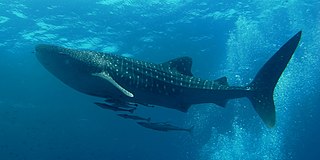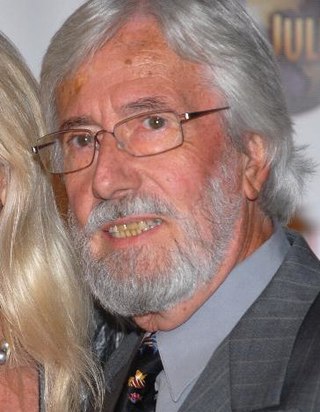
The hammerhead sharks are a group of sharks that form the family Sphyrnidae, named for the unusual and distinctive form of their heads, which are flattened and laterally extended into a cephalofoil. The shark's eyes are placed one on either end of this T-shaped structure, with their small mouths directly centered and underneath. Most hammerhead species are placed in the genus Sphyrna, while the winghead shark is placed in its own genus, Eusphyra. Many different— but not necessarily mutually exclusive—functions have been postulated for the cephalofoil, including sensory reception, manoeuvering, and prey manipulation. The cephalofoil gives the shark superior binocular vision and depth perception.

Sharks are a group of elasmobranch fish characterized by a cartilaginous skeleton, five to seven gill slits on the sides of the head, and pectoral fins that are not fused to the head. Modern sharks are classified within the clade Selachimorpha and are the sister group to the Batoidea. Some sources extend the term "shark" as an informal category including extinct members of Chondrichthyes with a shark-like morphology, such as hybodonts. Shark-like chondrichthyans such as Cladoselache and Doliodus first appeared in the Devonian Period, though some fossilized chondrichthyan-like scales are as old as the Late Ordovician. The oldest confirmed modern sharks (selachimorphs) are known from the Early Jurassic, about 200 million years ago, though records of true sharks may extend back as far as the Permian.

The whale shark is a slow-moving, filter-feeding carpet shark and the largest known extant fish species. The largest confirmed individual had a length of 18.8 m (61.7 ft). The whale shark holds many records for size in the animal kingdom, most notably being by far the most massive living non-mammalian animal. It is the sole member of the genus Rhincodon and the only extant member of the family Rhincodontidae, which belongs to the subclass Elasmobranchii in the class Chondrichthyes. Before 1984 it was classified as Rhiniodon into Rhinodontidae.

Sea World is a marine mammal park, oceanarium, and theme park located on the Gold Coast, Queensland, Australia. It offers attractions such as rides and animal exhibits and promotes conservation through education and the rescue and rehabilitation of sick, injured or orphaned wildlife. The park is commercially linked to Warner Bros. Movie World and Wet'n'Wild Gold Coast as part of the theme park division of Village Roadshow. The park has no affiliation with an American park chain of a similar name.

A shark attack is an attack on a human by a shark. Every year, around 80 unprovoked attacks are reported worldwide. Despite their rarity, many people fear shark attacks after occasional serial attacks, such as the Jersey Shore shark attacks of 1916, and horror fiction and films such as the Jaws series. Out of more than 500 shark species, only three of them are responsible for a double-digit number of fatal, unprovoked attacks on humans: the great white, tiger, and bull. The oceanic whitetip has probably killed many more castaways, but these are not recorded in the statistics.

Georgia Aquarium is a public aquarium in Atlanta, Georgia, United States. It exhibits hundreds of species and thousands of animals across its seven major galleries, all of which reside in more than 11 million US gallons (42,000 m3) of water. It was the largest aquarium in the world from its opening in 2005 until 2012 when it was surpassed by the S.E.A. Aquarium in Singapore and the Chimelong Ocean Kingdom in China; the Georgia Aquarium remains the largest aquarium in the United States and the fourth largest in the world.

Jaws 3-D is a 1983 American horror film directed by Joe Alves and starring Dennis Quaid, Bess Armstrong, Lea Thompson and Louis Gossett Jr. It is the second sequel to Steven Spielberg's Jaws and the third installment in the Jaws franchise. The film follows the Brody children from the previous films to SeaWorld, a Florida marine park with underwater tunnels and lagoons. As the park prepares for opening, a young great white shark infiltrates the park from the sea, seemingly attacking and killing the park's employees. Once the shark is captured, it becomes apparent that a second, much larger shark also entered the park and was the real culprit.

The New England Aquarium is a nonprofit organization located in Boston, Massachusetts. The species exhibited include harbor and northern fur seals, California sea lions, African and southern rockhopper penguins, giant Pacific octopuses, weedy seadragons, and thousands of saltwater and freshwater fishes. In addition to the main aquarium building, attractions at Central Wharf include the Simons Theatre and the New England Aquarium Whale Watch. More than 1.3 million guests visited the aquarium each year prior to the outbreak of the COVID-19 pandemic.

The 1992 cageless shark-diving expedition was the world's first recorded intentionally cageless dive with great white sharks, contributing to a change in public opinions about the supposed ferocity of these animals.

Underwater World, also known as Underwater World Singapore Pte Ltd, was an oceanarium located on the offshore Singaporean island of Sentosa. It was opened on 13 May 1991 and closed on 26 June 2016.

Jean-Michel Cousteau is a French oceanographic explorer, environmentalist, educator and film producer. The first son of ocean explorer Jacques Cousteau, he is the father of Fabien Cousteau and Céline Cousteau.

An oceanarium can be either a marine mammal park, such as Marineland of Canada, or a large-scale aquarium, such as the Lisbon Oceanarium, presenting an ocean habitat with marine animals, especially large ocean dwellers such as sharks.
SEA LIFE Sydney Aquarium is a public aquarium that features a large variety of Australian aquatic life, displaying more than 700 species comprising more than 13,000 individual fish and other sea and water creatures from most of Australia's water habitats. Opened in 1988, it is regarded as one of Sydney's premier tourist attractions with over 55% of its visitors each year coming from overseas.
Shark Week is an annual, week long TV programming block at the Discovery Channel, which features shark-based programming. Shark Week originally premiered on July 17, 1988. Featured annually, in July or early August, it was originally devoted to conservation efforts and correcting misconceptions about sharks. Over time, it grew in popularity and became a hit on the Discovery Channel. Since 2010, it has been the longest-running cable television programming event in history. Broadcast in over 72 countries, Shark Week is promoted heavily via social networks like Facebook and Twitter. Episodes are also available for purchase on services like Google Play Movies & TV/YouTube, Amazon Video, and iTunes. Some episodes are free on subscription-based Hulu and Discovery+.

Shark finning is the act of removing fins from sharks and discarding the rest of the shark back into the ocean. This act is prohibited in many countries. The sharks are often still alive when discarded, but without their fins. Unable to swim effectively, they sink to the bottom of the ocean and die of suffocation or are eaten by other predators. Shark finning at sea enables fishing vessels to increase profitability and increase the number of sharks harvested, as they must only store and transport the fins, by far the most profitable part of the shark; the shark meat is bulky to transport. Many countries have banned this practice and require the whole shark to be brought back to port before removing the fins.

Six Flags Discovery Kingdom is a 135-acre (55 ha) animal theme park located in Vallejo, California, off of Interstate 80 between San Francisco and Sacramento. The park includes a variety of roller coasters and other amusement rides. Six Flags Discovery Kingdom has been part of the Six Flags chain of amusement parks since 1999.

Marine conservation activism is the efforts of non-governmental organizations and individuals to bring about social and political change in the area of marine conservation. Marine conservation is properly conceived as a set of management strategies for the protection and preservation of ecosystems in oceans and seas. Activists raise public awareness and support for conservation, while pushing governments and corporations to practice sound ocean management, create conservation policy, and enforce existing laws and policy through effective regulation. There are many different kinds of organizations and agencies that work toward these common goals. They all are a part of the growing movement that is ocean conservation. These organizations fight for many causes including stopping pollution, overfishing, whaling and by-catching, and supporting marine protected areas.

Michael Rutzen is a South African conservationist, film maker and cage diving operator.

The Great Aquarium – Saint-Malo is an aquarium in Saint-Malo, France. It opened in 1996 and now belongs to the group Compagnie des Alpes, which also owns many other parks in France and Europe. The aquarium houses 11,000 marine animals representing 600 species. It covers 4,000 square metres (43,000 sq ft) and holds 2,500,000 litres (660,000 US gal) of water . 360,000 people visit this site each year making it the second most visited tourist site in Brittany.

Sea Life Bangkok Ocean World is an aquarium in Bangkok, Thailand and is the largest in South East Asia. It covers approximately 10,000 square meters (110,000 sq ft) with hundreds of different species on display in exhibits totaling about 5,000,000 liters (1,300,000 U.S. gal).
















